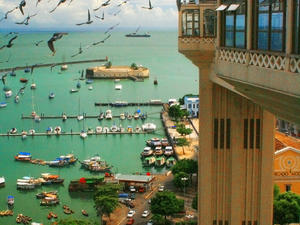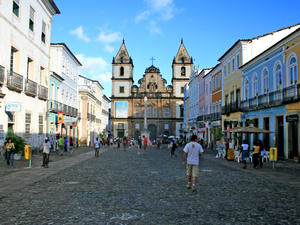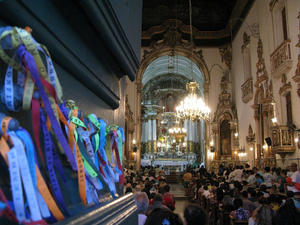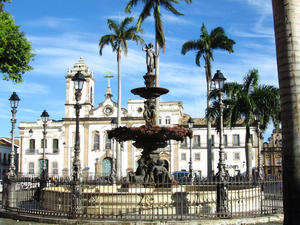 Elevador Lacerda - MAP 7
This fun attraction features a total of four elevators, which can transport up to 128 people on each trip, and reamins operational 24-hours a day. It's open daily and there is no cost associated with taking the trip up top where it's possible to get a great view of the city and ocean.
Created in 1868 by a wealthy local businessman, Antonio Francisco de Lacerda, the very stylish Elevador Lacerda is rather... Elevador Lacerda - MAP 7
This fun attraction features a total of four elevators, which can transport up to 128 people on each trip, and reamins operational 24-hours a day. It's open daily and there is no cost associated with taking the trip up top where it's possible to get a great view of the city and ocean.
Created in 1868 by a wealthy local businessman, Antonio Francisco de Lacerda, the very stylish Elevador Lacerda is rather... |
 Largo do Pelourinho - MAP 3 Largo do Pelourinho is a historical part of Salvador and considered a city within a city. Lots of historic buildings within this area.
It is one of the main symbols of Salvador. During slavery times, was the place where slaves were punished. The square is surrounded by several old houses in the purest colonial style, including the house of Jorge Amado Foundation and churches like the Church of the Rosary of Black Men and Cathe... Largo do Pelourinho - MAP 3 Largo do Pelourinho is a historical part of Salvador and considered a city within a city. Lots of historic buildings within this area.
It is one of the main symbols of Salvador. During slavery times, was the place where slaves were punished. The square is surrounded by several old houses in the purest colonial style, including the house of Jorge Amado Foundation and churches like the Church of the Rosary of Black Men and Cathe... |
 Nosso Senhor do Bonfim Church - MAP The church is named after the patron saint of Bahia is also a symbol of religious syncretism in Salvador. The tradition of washing the staircase and atrium with water began to smell with the slaves, in preparation for the feast in honor of the saint in January, and is maintained today by the Bahian Candomble. Another famous brand is the ribbon: Nobody leaves here without tying it on the wrist or at the gate.
The Church of Nosso Sen... Nosso Senhor do Bonfim Church - MAP The church is named after the patron saint of Bahia is also a symbol of religious syncretism in Salvador. The tradition of washing the staircase and atrium with water began to smell with the slaves, in preparation for the feast in honor of the saint in January, and is maintained today by the Bahian Candomble. Another famous brand is the ribbon: Nobody leaves here without tying it on the wrist or at the gate.
The Church of Nosso Sen... |
 Praça da Sé - MAP 6
For three centuries, the temple built in 1553 was an important place of religious practices for the local people of Bahia. In 1933, however, to meet the needs of urbanization of the city, the old cathedral was demolished to gave way to a tram-train line. In 1940, a public transport terminal was inaugurated in the site.
In 1982, with the opening of another major terminal, Terminal Lapa, the Cathedral region entered... Praça da Sé - MAP 6
For three centuries, the temple built in 1553 was an important place of religious practices for the local people of Bahia. In 1933, however, to meet the needs of urbanization of the city, the old cathedral was demolished to gave way to a tram-train line. In 1940, a public transport terminal was inaugurated in the site.
In 1982, with the opening of another major terminal, Terminal Lapa, the Cathedral region entered... |
 Elevador Lacerda - MAP 7
This fun attraction features a total of four elevators, which can transport up to 128 people on each trip, and reamins operational 24-hours a day. It's open daily and there is no cost associated with taking the trip up top where it's possible to get a great view of the city and ocean.
Created in 1868 by a wealthy local businessman, Antonio Francisco de Lacerda, the very stylish Elevador Lacerda is rather...
Elevador Lacerda - MAP 7
This fun attraction features a total of four elevators, which can transport up to 128 people on each trip, and reamins operational 24-hours a day. It's open daily and there is no cost associated with taking the trip up top where it's possible to get a great view of the city and ocean.
Created in 1868 by a wealthy local businessman, Antonio Francisco de Lacerda, the very stylish Elevador Lacerda is rather... Largo do Pelourinho - MAP 3 Largo do Pelourinho is a historical part of Salvador and considered a city within a city. Lots of historic buildings within this area.
It is one of the main symbols of Salvador. During slavery times, was the place where slaves were punished. The square is surrounded by several old houses in the purest colonial style, including the house of Jorge Amado Foundation and churches like the Church of the Rosary of Black Men and Cathe...
Largo do Pelourinho - MAP 3 Largo do Pelourinho is a historical part of Salvador and considered a city within a city. Lots of historic buildings within this area.
It is one of the main symbols of Salvador. During slavery times, was the place where slaves were punished. The square is surrounded by several old houses in the purest colonial style, including the house of Jorge Amado Foundation and churches like the Church of the Rosary of Black Men and Cathe... Nosso Senhor do Bonfim Church - MAP The church is named after the patron saint of Bahia is also a symbol of religious syncretism in Salvador. The tradition of washing the staircase and atrium with water began to smell with the slaves, in preparation for the feast in honor of the saint in January, and is maintained today by the Bahian Candomble. Another famous brand is the ribbon: Nobody leaves here without tying it on the wrist or at the gate.
The Church of Nosso Sen...
Nosso Senhor do Bonfim Church - MAP The church is named after the patron saint of Bahia is also a symbol of religious syncretism in Salvador. The tradition of washing the staircase and atrium with water began to smell with the slaves, in preparation for the feast in honor of the saint in January, and is maintained today by the Bahian Candomble. Another famous brand is the ribbon: Nobody leaves here without tying it on the wrist or at the gate.
The Church of Nosso Sen... Praça da Sé - MAP 6
For three centuries, the temple built in 1553 was an important place of religious practices for the local people of Bahia. In 1933, however, to meet the needs of urbanization of the city, the old cathedral was demolished to gave way to a tram-train line. In 1940, a public transport terminal was inaugurated in the site.
In 1982, with the opening of another major terminal, Terminal Lapa, the Cathedral region entered...
Praça da Sé - MAP 6
For three centuries, the temple built in 1553 was an important place of religious practices for the local people of Bahia. In 1933, however, to meet the needs of urbanization of the city, the old cathedral was demolished to gave way to a tram-train line. In 1940, a public transport terminal was inaugurated in the site.
In 1982, with the opening of another major terminal, Terminal Lapa, the Cathedral region entered...